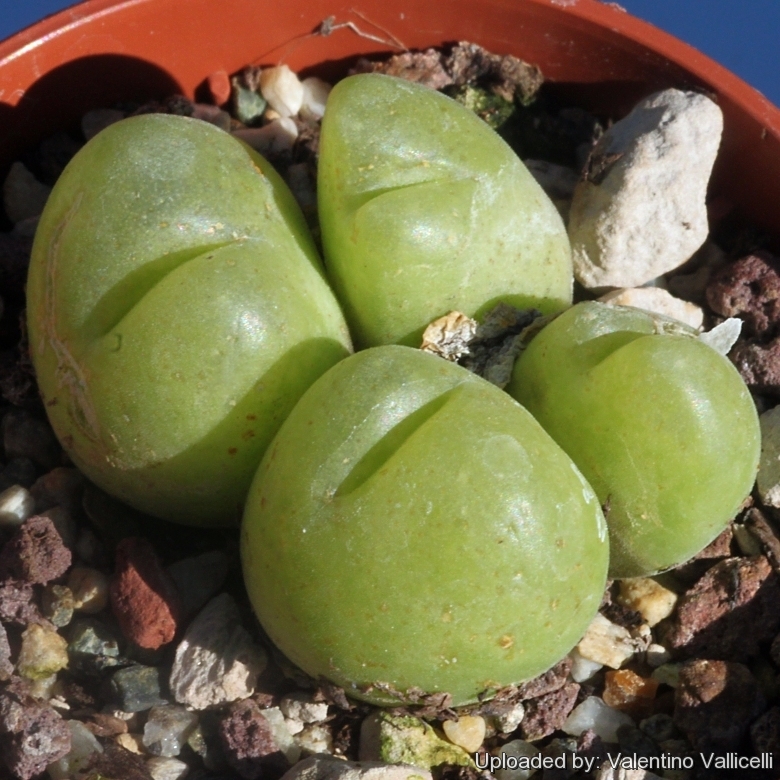= Gibbaeum cryptopodium (Kensit) L. Bolus
Notes Mesembryanthemum [H.M.L. Bolus] 2: 402 1933 L. Bolus
Accepted Scientific Name: Gibbaeum nuciforme (Haw.) Glen & H.E.K.Hartmann
Illustr. Handb. Succ. Pl.: Aizoaceae A-E (ed. H.E.K.Hartmann) 40 2002 publ. 2001 H.E.K.Hartmann

Derenbergia cryptopodia (Gibbaeum cryptopodium) Photo by: Valentino Vallicelli
SB642 (Collector: Steven Brack) Locality: Brandrivier, Little Karoo, South Cape Province, South Africa.
Origin and Habitat: Gibbaeum cryptopodiumSN|22704]]SN|22704]] occurs in the Little Karoo, Cape Province, South Africa. The plants have a fairly wide distribution and are found from west of Ladismith to south of Oudtshoorn.
Altitude: 530 - 850 m
Habitat: Grows in stony semi-desert areas usually associated with quartz debris, sandstone, or purple slates over a substrate of clay and shale but more to the east the plants can also occur amongst ferri-crete pebbles. In dry periods they may be partly underground and just the tips of the leaves are visible.
Synonyms:
See all synonyms of Gibbaeum nuciforme
back
Accepted name in llifle Database:Gibbaeum nuciforme (Haw.) Glen & H.E.K.HartmannIllustr. Handb. Succ. Pl.: Aizoaceae A-E (ed. H.E.K.Hartmann) 40 2002 publ. 2001Synonymy: 8
back
Description: It is a dwarf succulent with globular leaves occurring in attached pairs. It forms clumps with erect, decumbent and prostrate branches and pink flowers which appear in winter. It is similar to Gibbaeum pilosulumSN|14511]]SN|14511]] but plants white-pubescent to glabrous.
Body (paired leaves): 1-2.5 cm. Spherical to ovoid, highly succulent, semi-translucent, soft to the touch, pale or yellowish green, sometimes red-tinged. Leaves almost equal to distinctly unequal. connate for most of their length covered with short white hairs, or hairless at the top. Fissure short at the apex. Older leaves form a yellowish to ochre parchment-like sheath around the new leaves and persist for several years.
Flowers: 2,5 cm in diameter, petals pink about 35 in 2 rows. Pedicel invisible (enclosed in the body).
Blooming season:Winter. In the northern emisphere G. cryptopodium and the similar Gibbaeum pilosulumSN|14511]]SN|14511]] are often in bloom at Christmas.
Fuit: 6-locular capsusle, stalk About 5-12(-20) mm long with narrow wings, base infundibuliform, top conical, rims low.
Bibliography: Major references and further lectures
1) Heidrun E. K. Hartmann “Illustrated Handbook of Succulent Plants: Aizoaceae F-Z” Springer, 2002
2) Gert C. Nel “The Gibbaeum Handbook, a Genus of Highly Succulent Plants, Native to South Africa” Blandford Press, 1953
3) Hermann Jacobsen “A handbook of succulent plants: descriptions, synonyms, and cultural details for succulents other than Cactaceae, Volume 1” Blandford Press, 1960
4)Werner Rauh “The Wonderful World of Succulents: Cultivation and Description of Selected Succulent Plants Other Than Cacti” Smithsonian Institution Press, 1984
5) Goldblatt, P. and Manning, J.C. 2000. "Cape Plants: A conspectus of the Cape Flora of South Africa." Strelitzia 9. National Botanical Institute, Cape Town.
6) Hilton-Taylor, C. 1996. "Red data list of southern African plants." Strelitzia 4. South African National Botanical Institute, Pretoria.
7) Vlok, J. and Schutte-Vlok, A.L. 2010. "Plants of the Klein Karoo." Umdaus Press, Hatfield.
Cultivation and Propagation: This plant grows on winter rain regions and heads for summer dormancy. The growing season in northern hemisphere is from September to March. It is notoriously difficult to grow because it rot very easily.
Soil: It grows best in sandy-gritty soil and requires good drainage as it it is prone to root rot. It can grows outdoor in sunny, dry, rock crevices (protection against winter wet is required) It can also be cultivated in alpine house, in poor, drained soil.
Repotting: It may stay in the same pot for many years. Plants grown in larger containers have frequently relatively poor flowers. They might improve when the plants are given their own, small individual pots.
Fertilization: Feed it once during the growing season with a fertilizer specifically formulated for cactus and succulents (poor in nitrogen), including all micro nutrients and trace elements diluted to ½ the strength recommended on the label. It thrives in poor soils and need a limited supplies of fertilizer to avoid the plants developing excess vegetation, which is easily attacked by fungal diseases.
Watering: The Gibbaeums thrive in dry and desert regions and are able to stand extended periods of drought and require careful watering. Water minimally in summer, (only occasional misting), water more abundantly when they are growing in the autumn and spring, but let the soil dry between soaking. Requires little water otherwise its epidermis breaks (resulting in unsightly scars). If grown in a container, bottom watering by immersing the container is recommended. It must have very dry atmosphere.
Light: It needs a bright sunny or light shade exposure in winter, but keep cool and shaded in summer.
Hardiness: It prefer a very bright situation and require a minimum temperature 5°C (But will take a light frost and is hardy down to -7° C for short periods if it is in dry soil). USDA zones 9A – 11.
Uses: Container, rock garden.
Pests and diseases: It is vulnerable to mealybugs and rarely scale.
Propagation: Seed in autumn or (or rarely) cuttings. Take the cutting from a grown-up mother plant. Each cutting must contain one or more heads along with a fraction of root and permit to dry out a couple of days, lay it on the soil and insert the stem end partially into the soil. Try to keep the cutting somewhat upright so that the roots are able to grow downward. It is relatively difficult to root Gibbaeums from cuttings and generally pointless as well, so quick are they from seed.










